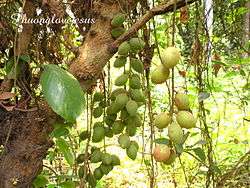Baccaurea ramiflora
| Baccaurea ramiflora | |
|---|---|
 | |
| Baccaurea ramiflora | |
| Scientific classification | |
| Kingdom: | Plantae |
| (unranked): | Angiosperms |
| (unranked): | Eudicots |
| (unranked): | Rosids |
| Order: | Malpighiales |
| Family: | Phyllanthaceae |
| Genus: | Baccaurea |
| Species: | B. ramiflora |
| Binomial name | |
| Baccaurea ramiflora Lour. | |
Baccaurea ramiflora (Burmese grape) is a slow growing evergreen tree in the Phyllanthaceae family, growing to 25 m, with a spreading crown and thin bark. It is found throughout Asia, most commonly cultivated in India and Malaysia. It grows in evergreen forests on a wide range of soils. The fruit is harvested and used locally, eaten as a fruit, stewed or made into wine; it is also used medicinally to treat skin diseases. The bark, roots and wood are harvested for medicinal uses.
The fruit is oval, colored yellowish, pinkish to bright red or purple, 2.5-3.5 cm in diameter, glabrous, with 2-4 large purple-red seed, with white aril.
Bark, roots and wood are dried and ground before boiling in water. Fruits can be kept fresh for 4–5 days, or boiled and mixed with salt after which it is keeps well closed jars. Marginal importance of the fruit, locally used and sold.
Other names
- English: Burmese grape
- Thai: mafai (มะไฟ), mak fai pa, khi mi, sae khrua sae, somfai, hamkang, pha yio
- Vietnamese: giâu gia đất
- Burmese: kan'zaw
- Bengali : Lot-kon(লটকন), Bhubhi(ভূভী)
- Cambodian: Plae-Phnhiew (ផ្លែផ្ញៀវ)
- Local names: Phu noi: cha chouay see
- Hindi : Khattaphal
- Assamese : leteku (লেটেকু), Bhubhi(ভূভী)
- Khasi : Sohramdieng
- Garo :Gasampe
- Somalian:Da Diaoguai
External links
| Wikimedia Commons has media related to Baccaurea ramiflora. |